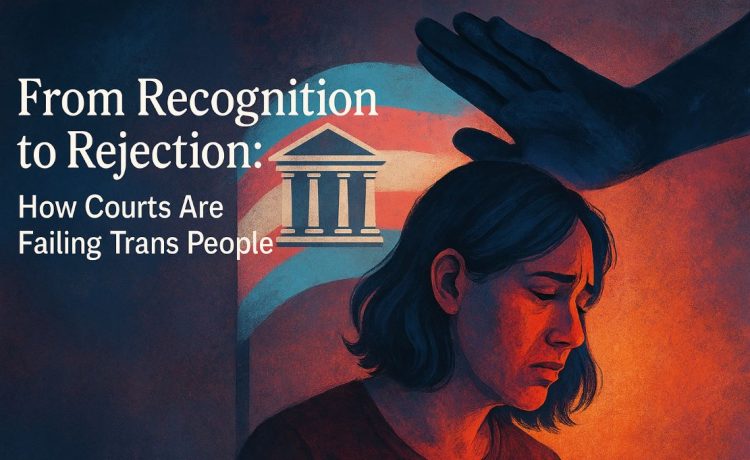Trans Exclusion Rulings Signal Troubling Shift Towards Far-Right Ideology
By Kavita Krishnan | Feminist Activist & Writer | Courtesy: The Hindu
A Blow to Trans Rights in the U.K.
In a landmark ruling, the U.K. Supreme Court has decided that trans women will not be treated as women under the Equality Act, 2010. This verdict has significant implications for the rights and legal protections of trans individuals, effectively undermining the Gender Recognition Act, 2004, which had been a cornerstone of trans rights in the country.
The ruling is being hailed by far-right groups and has sparked widespread concern among human rights advocates. Critics warn that it paves the way for greater social exclusion and reinforces discriminatory attitudes under the guise of protecting “common sense” and “women’s safety.”
Global Trend of Exclusionary Policies
This decision mirrors a growing global trend. In January, former U.S. President Donald Trump issued an executive order declaring his administration would recognize only two sexes: male and female. Trump justified the move by claiming it “restores sense,” a sentiment that resonates with those promoting exclusionary ideologies.
These developments are part of a broader strategy by far-right forces to reassert rigid gender binaries and roll back the rights of minorities. Trans exclusion has become the last socially acceptable form of bigotry—one that serves as a gateway for other forms of prejudice to re-enter mainstream discourse under the banner of tradition and order.
Feminist Divide Over ‘Common Sense’
Surprisingly, some self-identified feminists have supported the recent U.K. ruling. A prominent member of a historic South Asian and Black feminist collective welcomed the judgment for upholding “common sense” and protecting “safe, single-sex spaces.”
This alignment with far-right narratives has raised eyebrows. “Why are people who consider themselves anti-fascist celebrating a verdict that’s being championed by global right-wing figures?” is a question being asked in many circles. The answer may lie in how the campaign for trans exclusion has been repackaged as a feminist cause—concerned with protecting cisgender women and girls from perceived threats.

Rowling, Musk, and the Politics of Influence
Public figures like J.K. Rowling and Elon Musk have played a major role in shaping this narrative. Rowling has argued that excluding trans women from women’s spaces is necessary to ensure safety. In her view, women and girls must be protected from trans individuals, whom she implies are potential impostors.
Yet this narrative ignores the lack of evidence linking trans inclusion to harm. Critics argue that such fear-mongering closely resembles far-right talking points used to demonize other minorities—whether it’s migrants, Muslims, or queer people.
“Minorities are framed as threats to majorities, reversing power structures in a way that is not only misleading but dangerous,” warns Krishnan.
Unpacking the ‘Replacement’ Narrative
The fear that women are being “replaced” by trans women is rooted in the same logic as the far-right “Great Replacement” theory—an unfounded belief that dominant groups are being demographically replaced by minorities.
“There is no scientific basis for these ideas,” says Krishnan. “Yet many who reject climate science or vaccine data are quick to accept, without evidence, the idea that trans women are overtaking cisgender women in sports or public life.”
Scientific consensus, in contrast, affirms the biological and neurological diversity of gender. Research continues to uncover variations in hormones, chromosomes, and brain structure that support the existence of diverse sexual identities beyond the male-female binary.
False Equivalence of Segregation
Proposals to offer “separate but equal” spaces for trans individuals—such as different bathrooms or shelters—echo the logic of racial segregation. Such policies, critics argue, only reinforce marginalisation and social hostility.
“Segregating trans women from other women will make public spaces more hostile to all women,” Krishnan argues. “It invites scrutiny of every woman’s body, demanding proof of her femininity.”
This logic was tragically illustrated in the case of boxer Imane Khelif, who was assigned female at birth but was still misgendered publicly. The implication: unless a woman fits traditional standards, she is suspect.
Science, Language, and Human Dignity
Detractors often invoke “science” to deny the existence of trans identities. However, modern biology acknowledges the complexity and spectrum of sex and gender. Sexual diversity is as biologically real as neurodiversity.
Language, too, is evolving to reflect this understanding. The singular “they,” once debated, is now widely accepted as a gender-neutral pronoun. Resistance to such changes, Krishnan notes, is part of a broader discomfort with shifting social norms.
“Science, law, and language can’t erase trans people—just as they couldn’t erase gay people,” she writes. “One day, the binary view of sex will seem as absurd as believing the earth is flat.”
Conclusion
The fight for trans rights is not just about individual identity—it is a litmus test for the values of justice, equality, and inclusivity in society. As exclusionary ideologies gain ground, it becomes increasingly urgent to challenge the myths they propagate and defend the rights of all individuals to live with dignity and recognition.
![]()











